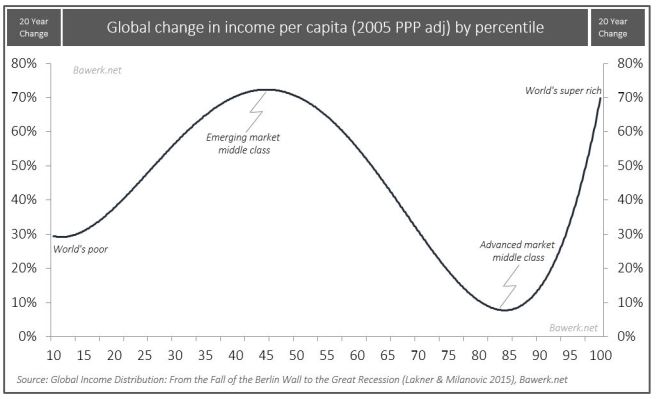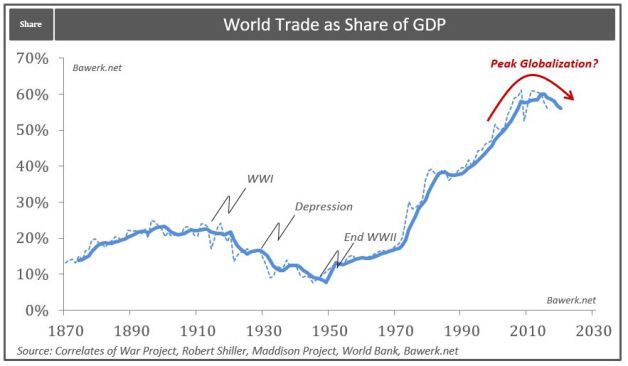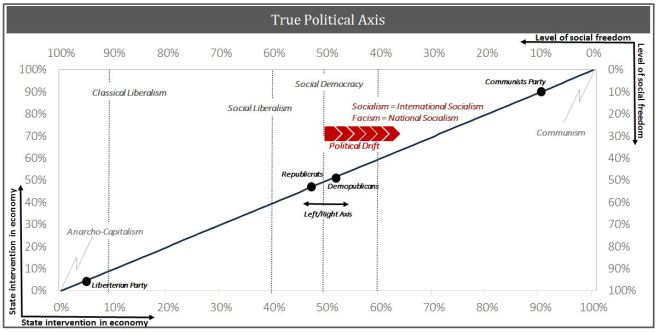True Political Axis One of the most widespread misconceptions in the realm of politics is the notion of a left-right axis. This has been used over and over to explain political outcomes and paint the various factions as polar opposites. For example, in the US the two main parties, the Republicans (right) and Democrats (left), are often portrayed as a fight between good and evil. Which party representing good and which one is advocates of evil is highly subjective and obviously, “our” team is always considered good, while “they” are evil. Then there are factions to the right and left of mainstream parties which are then considered extreme versions of left and right. To the right of right-of-center you find somewhat confusing a hodgepodge of various totally unrelated groupings such free-market libertarians, racists and fascists. On the left of left-of-center we find the usual socialists and communists. This makes very little sense and as we have shown on these pages earlier, the chart below gives a much better description of the political reality. Libertarians are the polar opposite of fascists, but the left-right axis bundle them together on the far right side. By doing so libertarians are easy to dismiss as simple-minded racists.
Topics:
Eugen von Böhm Bawerk considers the following as important: Bawerk, Economics, Europe, Featured, Geopolitics, newslettersent, U.K., US
This could be interesting, too:
Nachrichten Ticker - www.finanzen.ch writes Die Performance der Kryptowährungen in KW 9: Das hat sich bei Bitcoin, Ether & Co. getan
Nachrichten Ticker - www.finanzen.ch writes Wer verbirgt sich hinter der Ethereum-Technologie?
Marc Chandler writes March 2025 Monthly
Mark Thornton writes Is Amazon a Union-Busting Leviathan?
True Political AxisOne of the most widespread misconceptions in the realm of politics is the notion of a left-right axis. This has been used over and over to explain political outcomes and paint the various factions as polar opposites. For example, in the US the two main parties, the Republicans (right) and Democrats (left), are often portrayed as a fight between good and evil. Which party representing good and which one is advocates of evil is highly subjective and obviously, “our” team is always considered good, while “they” are evil. Then there are factions to the right and left of mainstream parties which are then considered extreme versions of left and right. To the right of right-of-center you find somewhat confusing a hodgepodge of various totally unrelated groupings such free-market libertarians, racists and fascists. On the left of left-of-center we find the usual socialists and communists. This makes very little sense and as we have shown on these pages earlier, the chart below gives a much better description of the political reality. Libertarians are the polar opposite of fascists, but the left-right axis bundle them together on the far right side. By doing so libertarians are easy to dismiss as simple-minded racists. This blurs political concepts and directly baffles pundits and commentators alike when results such as Brexit and Trump “surprisingly” go against conventional wisdom. How can the “extreme” rightwing Trump win Democratic stronghold states such as Pennsylvania, Michigan and Wisconsin? They should, in theory, be diametrical opposite. One simple example should suffice to prove our point; an elderly gentleman with more than thirty years’ experience as a geopolitical advisor claimed that Ludwig von Mises, a Jewish libertarian living in Austria in the 1930s, was clearly a staunch fascist. Even the professionals or maybe them more than any, are fooled by this false dichotomy which help explain why people today are shocked by what is going on in the Western World. |
True Political Axis |
Change in income per CapitaWe see things very different; to the northeast in our chart, we find political parties favoring more government intrusion to both economic and social life, while the southwest represents individual freedom. To make the chart complete there should be a third axis denoting international socialism/fascism and national socialism/fascism. The current power elite support the welfare state, heavy regulation of economic activity and social control over the masses. It is true that some want more economic regulation (Democrats) and some want more social control (Republicans; gay marriage, abortion. Democrats; political correctness = stifling free speech, especially aimed at the attitudes in “Flyover America”), but there are consensus on the need to control and intervene heavily. The current political elite also supports internationalism under the auspice of “globalism” where migration, trade and capital are relatively free to move as it sees fit. This has obviously led to higher wage gains for the world’s lower middle class and lower wage gains for the higher middle class as the world labor market have become more unified. In addition, asset holders throughout the world has also benefited, especially from a global monetary policy that has provided the impetus for a decoupling between underlying fundamentals and the price of securities that are supposed to represent an economy’s productive potential. |
 |
World Trade as Share of GDPWithin this economic, financial and political climate the international socialist are bound to lose. In enter the national socialists. They promise to return to the good old days when a union worker at the GM factory made USD100k plus full benefits. They tell people the welfare state will be there for them. They will force companies to bring off-shored jobs back home. They will stop immigration. Bottom line, they promise to re-create socialism without globalism. Socialism for the nation state. The key point is that the political distance between a vote for the international socialist and the national socialist voter is miniscule. A blue-collar worker in Pennsylvania, downtrodden by years of hardship, will easily switch to the party that promises to restore old glory days. Pundits are obviously puzzled – how can a union man vote for the party for the rich? How can he vote for a party that are miles away from his political self-interest? The answer of course is that the union man is not. He is rationally voting for a party closely resembling the one he used to vote for, only this one comes with a slightly new rhetoric. Which is exactly why we will see more shocks to the system as national elections will yield results that upset the status quo in the Netherlands, France, Germany and potentially Italy and the UK by the end of 2017. Be prepared for a new world order. With that in mind, we close with a chart that perfectly sums up the world we see before us. Not only are we at peak debt with subsequent peak asset prices, we are at the precipice of Peak globalization itself. |
 |
Listening to what Trump, Farage, Le Pen, Wilders and Grillo actually says one will soon realize that these are not libertarians. On the contrary, according to www.greatagain.gov the new Trump administration will expand fiscal policy by increasing infrastructure, military and other spending to the tune of USD2 – 3 trillion more than what is baked into the already unsustainable debt equation. So we wonder what Mr. Krugman is so upset about? This is exactly the fiscal stimulus left leaning economist have wanted for years. Movements in bonds markets since Trump was elected suggest Mr. Market believe it will come. Right wing Le Pen, Wilders and supposedly their opposite left wing Grillo are aiming for the same. Not one of these so-called populists talks about dismantling the European welfare state and reinstating 19-century pure capitalistic market pricing and resource allocation.
However, there are one main difference between the new movement spreading across the US and Europe in comparison to the struggling status quo. While still socialists, the new movement understand why the once affluent middle class of the western world are upset. They cannot make ends meet as they find themselves in a situation whereby the central bank target a domestic price level in a world where prices are set on global markets. To achieve a two per cent CPI target when import prices are falling due to the “China-factor”, it is given that non-tradable prices must grow far faster than two per cent. From this we can conclude that essentials, such as housing/rent, education, food and medical expenses will grow far faster than then aggregate CPI if the two per cent target is to be reached. Data from the Bureau of Labor Statistics substantiates this view.
While it is certainly nice to buy a new flat-screen TV imported from Asia on the cheap, it is not helping if housing, food and medical expenses already lay claim to all of household income. If these people dare vent their frustration, the urban elites call them racist bigots and effectively shut them down. Until 2008 Flyover America could effectively be silenced by giving them access to cheap and plentiful amounts of debt, which helped paper over the lack of real household income growth. When the credit channel broke down at peak debt, the harsh reality made itself felt.

